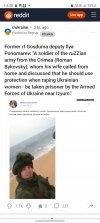Please olisi auttanut ymmärrystä.Aa, se "send" oli siis imperatiivimuoto, eikä monikon preesens
Install the app
How to install the app on iOS
Follow along with the video below to see how to install our site as a web app on your home screen.
Note: This feature may not be available in some browsers.
You are using an out of date browser. It may not display this or other websites correctly.
You should upgrade or use an alternative browser.
You should upgrade or use an alternative browser.
Ukrainan konflikti/sota
ido59
Majuri
Miten tuollainen drone-pyssy toimii ja vaikuttaa?
“It's what they inherited after the end of the Cold War,” said German Marshall Fund fellow Steven Keil. “It makes up a bulk of their own military capacity.”
In recent weeks, as the United States has worked to get weapons to Ukraine, it offered a deal to Eastern European and former Soviet Bloc countries that held stockpiles of Russian-specific munitions: If those countries would send their arms to Ukraine, the U.S. would replace them with NATO-standard guns, artillery, air defenses, and aircraft.
“From NATO’s point of view, this has been a win-win-win,” said Mark Cancian, a senior advisor at the Center for Strategic and International Studies. “It makes the logistics easier. And the supplying of weapons easier because you have a broader sort of set of suppliers.”

US Looks to Shift Ukraine from Soviet to NATO Weapons
“It would just be easier if we were using similar systems,” said one expert, as U.S. officials mull long–term efforts to resupply Ukraine’s arsenal.
Monday’s latest announcement of $322 million in foreign military financing—part of a massive $3.4 billion in security assistance from the United States to Ukraine since the war began—supports the continued purchase of Soviet-era munitions, for now. But “as these items become more difficult to procure, FMF could be used to assist with the [Armed Forces of Ukraine] transition to U.S./NATO caliber systems for long-range firing, including multiple launch rocket systems (MLRS) and artillery,” according to a summary of the aid obtained by Defense One.
Furthermore, the money can be used for “modernizing Ukraine's weapons inventory through the provision of more precise and capable weapons, including sniper rifles, rocket-propelled grenade launchers, and other small arms,” said a U.S. official who spoke to Defense One on background. That means those systems could also transition to NATO/U.S.-standard weaponry, if that is what Ukraine chooses.
“Up until now, we've been working at helping them meet their immediate needs,” the U.S. official said. “Now we're getting to the place where we need to start looking ahead to additional future possibilities.”
That has a strategic impact, Keil said.
“Using systems that are newer, newer generation aircraft or, more widely used caliber of artillery, is definitely in NATO's interest,” Keil said. “Particularly in the event of conflict … it would just be easier if we were using similar systems.”
Vaikutus on pyöreästi kilometrissa ja perustuu elektroniseen sodankäyntiin. Useat vehkeet ovat vieläkin protoja, koska kaikki on vaiheessa.Miten tuollainen drone-pyssy toimii ja vaikuttaa?
hyvis
Eversti
Amatöörinä, ja tietämättömyyden suomalla itsevarmuudella veikkaan, että vaikutusta on kahdenlaista. Toisella saadaan siviiliversiot hätälaskumoodiin koodatulla standardin mukaisella pulssilla ja toisella mahdollisesti suunnattu energiapulssi kärväyttää jotain dronesta.Miten tuollainen drone-pyssy toimii ja vaikuttaa?

AS90 matkalla rintamalle. Olisivat voineet maalata sen valmiiksi oliivin vihreäksi, tuon hiekkavärityksen sijasta.
Britain’s defence secretary says allies must move quickly to supply Ukraine with heavy artillery capable of at least matching Russia.
“The race is on to equip Ukraine with the same long-range capability that Russia has so they are not outranged and indeed pinned down,” Ben Wallace told Parliamentarians April 25.
“The next three weeks are key,” he added. “Ukraine needs more long-range artillery and ammunition, and both Russian and NATO caliber types to accompany them. It also seeks anti-ship missiles to counter Russian ships that are able to bombard Ukrainian cities.”

‘The race is on’: Britain moves to get heavy artillery to Ukraine
“The race is on to equip Ukraine with the same long-range capability that Russia has so they are not outranged and indeed pinned down,” Ben Wallace told Parliamentarians April 25.
Hyvin arvattu, kummatkin valideja metodeja. Kuten sanoin kaikki vehkeet on protoja. Myös sädettimet.Amatöörinä, ja tietämättömyyden suomalla itsevarmuudella veikkaan, että vaikutusta on kahdenlaista. Toisella saadaan siviiliversiot hätälaskumoodiin koodatulla standardin mukaisella pulssilla ja toisella mahdollisesti suunnattu energiapulssi kärväyttää jotain dronesta.
Kuvituskuva (https://www.defensenews.com/land/20...tzers-to-stick-around-amid-replacement-delay/) vuodelta 2003 Persianlahdelle matkalla olleesta AS90:stä. Eiköhän ne toimiteta sopivissa väreissä Ukrainaan.AS90 matkalla rintamalle. Olisivat voineet maalata sen valmiiksi oliivin vihreäksi, tuon hiekkavärityksen sijasta.
The National Geospatial-Intelligence Agency, which collects, analyzes and distributes satellite imagery in support of U.S. national security, is monitoring events in Ukraine and sharing intelligence with partner nations engaged in joint missions, its director said.
“We’ve been able to be a key part of the how the West has helped Ukraine prevent Russia from overrunning Kiev, and installing a puppet government subservient to Russian control,” said Vice Adm. Robert Sharp said at the GEOINT Conference in Denver April 25. “Today, on the 61st day of the war, Ukraine is bravely and impressively fighting on. Partnerships are critical to the ongoing success.”
The agency is engaged in supporting partners with geospatial intelligence, or GEOINT, throughout the conflict. The NGA is also sharing commercial imagery and encouraging U.S. companies to assist NATO.
“As far as what U.S. imagery companies are providing to assist NATO and the West in this situation, is NGA OK with all that, even encouraging it? Absolutely. Heck yeah! No restrictions,” said Sharp in prepared remarks. “Publicly available imagery of Ukraine is now providing unprecedented public insight that until recently would’ve been only available through government agencies and officials. And it’s helping a democratic country fight for its survival, and preserve its independence. We support and applaud those efforts 100 percent.”
Sharp said that many of the ways the NGA is providing support is classified, but he shared one example of how the agency is taking action.
In March, the agency sent personnel to the U.S. European Command Area of Operations to train some military partners on the Aerial Reconnaissance Tactical Edge Mapping Imagery System, or ARTEMIS. ARTEMIS is a small unmanned system used to provide overhead imagery when conditions are not ideal for satellite collection, explained Sharp.
“Due to this initiative, we now have military forces in Europe who can use ARTEMIS for high-resolution imagery, creating their own GEOINT at the tactical edge that can be easily shared at the unclassified level with international partners, and with no restrictions,” he said.

How one US intelligence agency is supporting Ukraine
“We’ve been able to be a key part of the how the West has helped Ukraine prevent Russia from overrunning Kiev," says NGA Director Vice Adm. Robert Sharp.
rty19
Greatest Leader
Ryssän kaasu on Saksalle paljon tärkeämpää kuin Ukrainan auttaminen. Välillä toki mainitaan jokin asejärjestelmä, jota ei sitten lopulta kuitenkaan Ukrainalle toimiteta, koska muuten syttyy kolmas maailmansota. Suhtaudun kyllä äärimmäisen skeptisesti saksalaiseen apuun.Leopardit, Marderit, PzH2K:t ovat twiittailijan omaa kommentointia mitä Saksan pitäisi lähettää. Gepardeistakaan Saksa ei ole tarkentanut vielä mitään määriä, tai toimitusaikaa. Jotenkin epäilen että niitä oltaisiin samantien kuljetukseen lastaamassa. Useampi viikko vähintään käyttöönottovatulointia siinä toivossa että sota ehtii sillä välin loppua.
Puolan selän takana on muutenkin hyvä olla piilossa ja tehdä bisnestä.
Living the dream. Pysykää turvassa pojat!
EkaVekara
Korpraali
Sanoivat, että ainakin osa olisi mielummin ottanut AK-kloonit, mutta menevät paikallisille jotka ovat siihen koulutettu. M4:sta kuulemma joutuu puhdistamaan kaksi kertaa päivässä vaikka ei suurin piirtein ampuisi laukaustakaan, ilmeisesti aroillakin puhaltaa hiekkaa. Luonnollisesti koko ryhmällä kannattanee olla samat pyssyt, ihan ammuslogisiikankin näkökulmasta.Pojilla on aika modernit tussarit, ei ole enää AK-47 -klooneja. Tuon yhden kuvan naamasensurointi ei ole "asetuksen mukainen". Liikaa infoa on jäänyt, tietokone osaa interpoloida takaisin aika hyvin nykyään.
Behind the headline-grabbing kinetic war, Russia’s attack on Ukraine has put a new focus on the importance of cybersecurity and satellite communications.
American satellite communications company Viasat probed an outage that impacted its coverage of Ukraine, and SpaceX deployed internet service and terminals to Ukraine, while simultaneously announcing that the company will shift resources to cybersecurity. The FBI and Cybersecurity and Infrastructure Security Agency issued a warning about the elevated risk.
The stakes are high if this threat escalates.
As impressive as kinetic attacks on satellites are, the biggest threat to these flying computers is from cyberattack. Such an attack that impairs commercial satellites can have an immediate impact on military capability.
The fear of cyberattack on satellites and ground infrastructure has been on the minds of government users for some time. Lt. Gen. Stephen Whiting, commander of the U.S. Space Force’s Space Operations Command, recently remarked: “Cyberspace is the soft underbelly of our global space networks.”
This threat stems in part from the increasing use of commercially operated satellite networks. America’s primary military wide-band communications satellite network reflects a model of satellite communications that is ending. When the first Wideband Global Satcom satellite took to flight in 2007, the government and its primary contractors built every ounce of the satellites and their infrastructure.

‘Zero trust’ can secure satellite communications against cyberattack
Joel Machen of SpiderOak Mission Systems argues the Defense Department should take a different approach to software and operations in satellite design and operations.
Laitoin tämän myös konflikti lähiavaruudessa ketjuun. Jenkit ovat sodan varjolla järjestäneet hackatoneja satelliitteja vastaan, aivan samanlailla kuin muuta vuosi sitten sama tehtiin pentagonin kanssa, ja viime vuonna muualla.
Satelliittit on tässä konfliktissa olleet auttamassa, mutta hyvin varjostetusti suuren yleisön silmissä. En sano että konflikti eskaloituu lähiavaruuteen, mutta jos heidän vittuuntuneisuus kiristyy myös tilanne kiertoradoilla voi kiristyä. Samalla se olisi uusi vaihe niin sodassa, kuin konflikteissa.
Viimesessä isossa maailmanpalossa sakut lanas Puolan siihen tyyliin, et uhreja väestöön nähden tuli vallan pirusti.... No nyt ne sitte lymyilee samaisen kansan takana... On tää perkele... Sakuille pitäis vähän antaa pakotteita....Ryssän kaasu on Saksalle paljon tärkeämpää kuin Ukrainan auttaminen. Välillä toki mainitaan jokin asejärjestelmä, jota ei sitten lopulta kuitenkaan Ukrainalle toimiteta, koska muuten syttyy kolmas maailmansota. Suhtaudun kyllä äärimmäisen skeptisesti saksalaiseen apuun.
Puolan selän takana on muutenkin hyvä olla piilossa ja tehdä bisnestä.
Helikoptereista sen verran, että n. kuukausi sitten oli laskelmaa, että Venäjän helikoptereiden kokemat tappiot olivat suhteessa niiden lukumäärään tankkejakin kovemmat. Venäjä on nyt menettänyt UA:n laskujen mukaan 154 helikopteria. Hyökkäyskopteri KA-52:sia on Ukrainassa mennyt 12; Venäjällä on käytössään koko maassa niitä satakunta, samoin kuin Mi-28 "Havoc" -hyökkäyskopteria, joita on tonttiin tullut ja kentille tuhottu niitäkin:
Katso liite: 60852
Venäjä on kahdessa kuukaudessa menettänyt koko asevoimiensa taisteluhelikoptereista ehkä sellaiset 10% ..
Loppuu ne kun lopetetaan!
Koneita ryssällä riittää, niin heloja kuin tankkejakin.
Lentävän kaluston osalta täytyy kuitenkin muistaa, että usein menetetään myös tärkeä(t) miehistö.
Osaavia lentäjiä naapurilla ei ole yhtään liikaa ollutkaan, nyt alkaa varmaan kovimmat ukot päätyneet tonttiin tai onnekkaimmat UA:n vangiksi.
Tankkimiehistöä riittää kyllä tapatettavaksi, ei siellä näytä olevan sillä puolella osaajia muutenkaan...

M4:t kaikilla ja M240 - Amerikkalaista aseapua?
hyvis
Eversti
Stonerin konstruktiot toimii öljyllä. Eli sitä pitäisi lotrata sen verran paljon, että vähän valuu joka paikasta - säännöllistä ja usein toistuvaa puhdistusta unohtamatta. Poikain pyssyt on kyllä puhtaita, mutta kovin kuivan näköisiä.Sanoivat, että ainakin osa olisi mielummin ottanut AK-kloonit, mutta menevät paikallisille jotka ovat siihen koulutettu. M4:sta kuulemma joutuu puhdistamaan kaksi kertaa päivässä vaikka ei suurin piirtein ampuisi laukaustakaan, ilmeisesti aroillakin puhaltaa hiekkaa.
Viimeksi muokattu:


